The Report of the Public Inquiry into children’s heart surgery at the Bristol Royal Infirmary 1984-1995
VerifiedAdded on 2023/06/03
|11
|2579
|246
AI Summary
This report discusses the findings and recommendations of the Public Inquiry into children’s heart surgery at the Bristol Royal Infirmary 1984-1995. It covers the poor information systems, leadership, healthcare monitoring, priority of very sick children, and lack of openness to information. The report recommends solutions such as empowering the public, elevating people with leadership skills, and ensuring timely quality assurance.
Contribute Materials
Your contribution can guide someone’s learning journey. Share your
documents today.
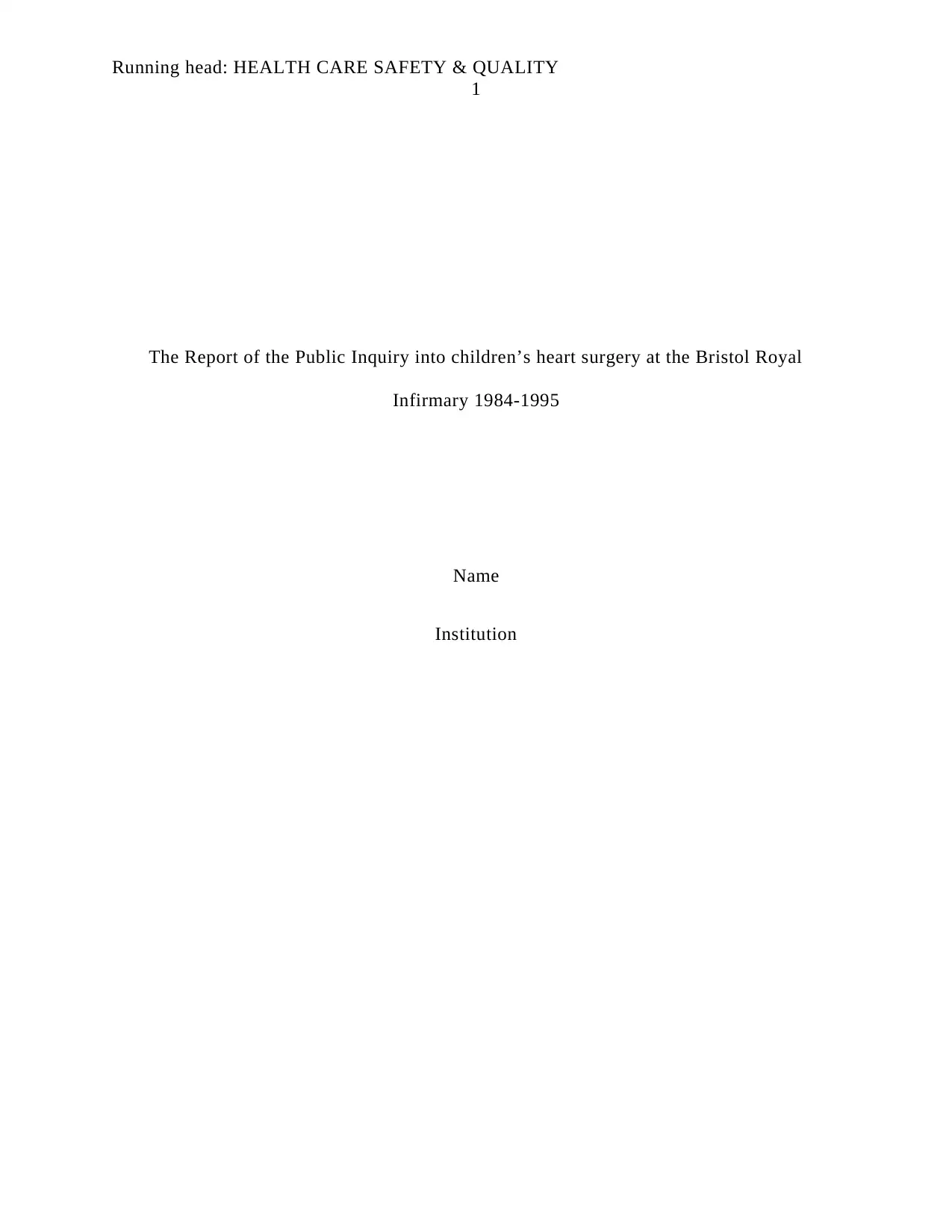
Running head: HEALTH CARE SAFETY & QUALITY
1
The Report of the Public Inquiry into children’s heart surgery at the Bristol Royal
Infirmary 1984-1995
Name
Institution
1
The Report of the Public Inquiry into children’s heart surgery at the Bristol Royal
Infirmary 1984-1995
Name
Institution
Secure Best Marks with AI Grader
Need help grading? Try our AI Grader for instant feedback on your assignments.
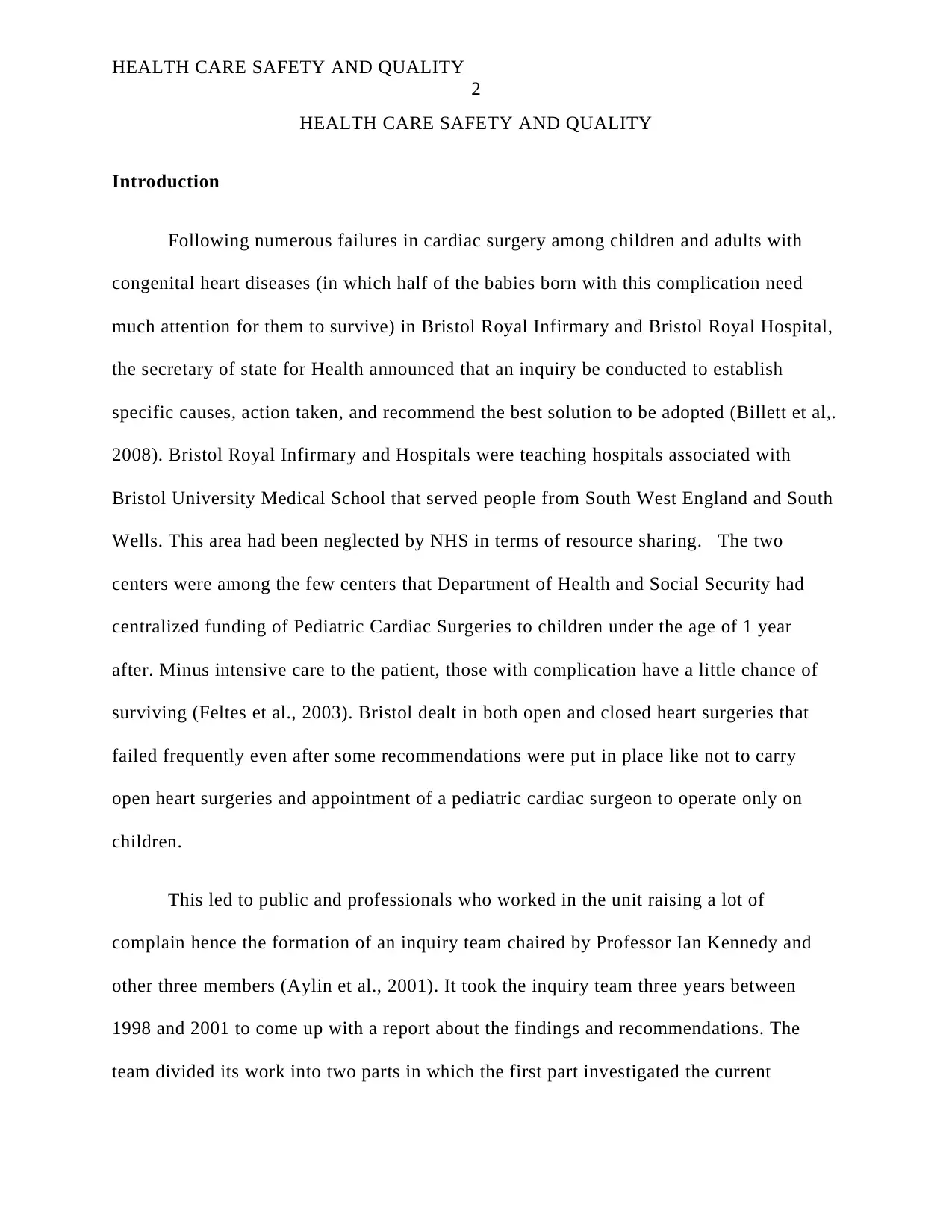
HEALTH CARE SAFETY AND QUALITY
2
HEALTH CARE SAFETY AND QUALITY
Introduction
Following numerous failures in cardiac surgery among children and adults with
congenital heart diseases (in which half of the babies born with this complication need
much attention for them to survive) in Bristol Royal Infirmary and Bristol Royal Hospital,
the secretary of state for Health announced that an inquiry be conducted to establish
specific causes, action taken, and recommend the best solution to be adopted (Billett et al,.
2008). Bristol Royal Infirmary and Hospitals were teaching hospitals associated with
Bristol University Medical School that served people from South West England and South
Wells. This area had been neglected by NHS in terms of resource sharing. The two
centers were among the few centers that Department of Health and Social Security had
centralized funding of Pediatric Cardiac Surgeries to children under the age of 1 year
after. Minus intensive care to the patient, those with complication have a little chance of
surviving (Feltes et al., 2003). Bristol dealt in both open and closed heart surgeries that
failed frequently even after some recommendations were put in place like not to carry
open heart surgeries and appointment of a pediatric cardiac surgeon to operate only on
children.
This led to public and professionals who worked in the unit raising a lot of
complain hence the formation of an inquiry team chaired by Professor Ian Kennedy and
other three members (Aylin et al., 2001). It took the inquiry team three years between
1998 and 2001 to come up with a report about the findings and recommendations. The
team divided its work into two parts in which the first part investigated the current
2
HEALTH CARE SAFETY AND QUALITY
Introduction
Following numerous failures in cardiac surgery among children and adults with
congenital heart diseases (in which half of the babies born with this complication need
much attention for them to survive) in Bristol Royal Infirmary and Bristol Royal Hospital,
the secretary of state for Health announced that an inquiry be conducted to establish
specific causes, action taken, and recommend the best solution to be adopted (Billett et al,.
2008). Bristol Royal Infirmary and Hospitals were teaching hospitals associated with
Bristol University Medical School that served people from South West England and South
Wells. This area had been neglected by NHS in terms of resource sharing. The two
centers were among the few centers that Department of Health and Social Security had
centralized funding of Pediatric Cardiac Surgeries to children under the age of 1 year
after. Minus intensive care to the patient, those with complication have a little chance of
surviving (Feltes et al., 2003). Bristol dealt in both open and closed heart surgeries that
failed frequently even after some recommendations were put in place like not to carry
open heart surgeries and appointment of a pediatric cardiac surgeon to operate only on
children.
This led to public and professionals who worked in the unit raising a lot of
complain hence the formation of an inquiry team chaired by Professor Ian Kennedy and
other three members (Aylin et al., 2001). It took the inquiry team three years between
1998 and 2001 to come up with a report about the findings and recommendations. The
team divided its work into two parts in which the first part investigated the current
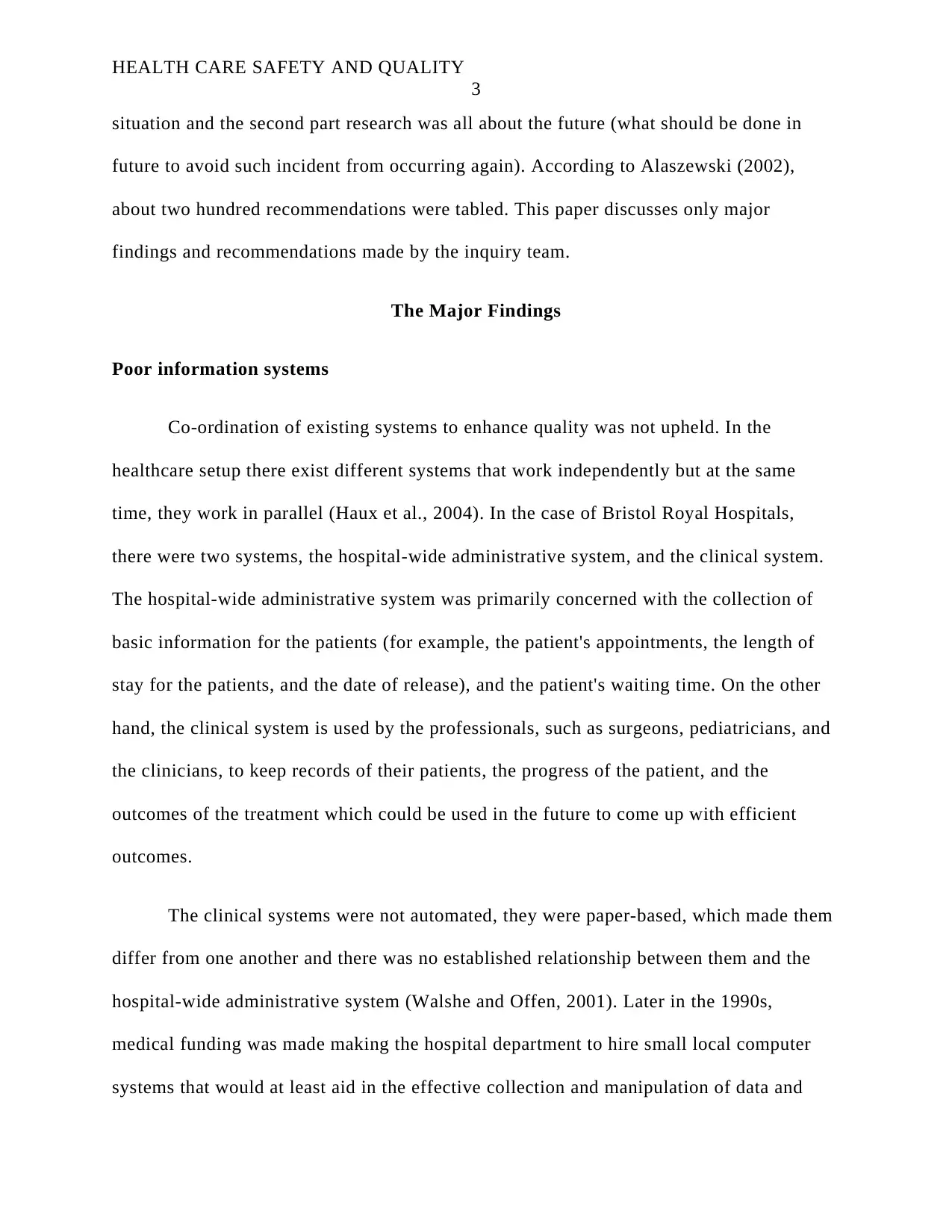
HEALTH CARE SAFETY AND QUALITY
3
situation and the second part research was all about the future (what should be done in
future to avoid such incident from occurring again). According to Alaszewski (2002),
about two hundred recommendations were tabled. This paper discusses only major
findings and recommendations made by the inquiry team.
The Major Findings
Poor information systems
Co-ordination of existing systems to enhance quality was not upheld. In the
healthcare setup there exist different systems that work independently but at the same
time, they work in parallel (Haux et al., 2004). In the case of Bristol Royal Hospitals,
there were two systems, the hospital-wide administrative system, and the clinical system.
The hospital-wide administrative system was primarily concerned with the collection of
basic information for the patients (for example, the patient's appointments, the length of
stay for the patients, and the date of release), and the patient's waiting time. On the other
hand, the clinical system is used by the professionals, such as surgeons, pediatricians, and
the clinicians, to keep records of their patients, the progress of the patient, and the
outcomes of the treatment which could be used in the future to come up with efficient
outcomes.
The clinical systems were not automated, they were paper-based, which made them
differ from one another and there was no established relationship between them and the
hospital-wide administrative system (Walshe and Offen, 2001). Later in the 1990s,
medical funding was made making the hospital department to hire small local computer
systems that would at least aid in the effective collection and manipulation of data and
3
situation and the second part research was all about the future (what should be done in
future to avoid such incident from occurring again). According to Alaszewski (2002),
about two hundred recommendations were tabled. This paper discusses only major
findings and recommendations made by the inquiry team.
The Major Findings
Poor information systems
Co-ordination of existing systems to enhance quality was not upheld. In the
healthcare setup there exist different systems that work independently but at the same
time, they work in parallel (Haux et al., 2004). In the case of Bristol Royal Hospitals,
there were two systems, the hospital-wide administrative system, and the clinical system.
The hospital-wide administrative system was primarily concerned with the collection of
basic information for the patients (for example, the patient's appointments, the length of
stay for the patients, and the date of release), and the patient's waiting time. On the other
hand, the clinical system is used by the professionals, such as surgeons, pediatricians, and
the clinicians, to keep records of their patients, the progress of the patient, and the
outcomes of the treatment which could be used in the future to come up with efficient
outcomes.
The clinical systems were not automated, they were paper-based, which made them
differ from one another and there was no established relationship between them and the
hospital-wide administrative system (Walshe and Offen, 2001). Later in the 1990s,
medical funding was made making the hospital department to hire small local computer
systems that would at least aid in the effective collection and manipulation of data and
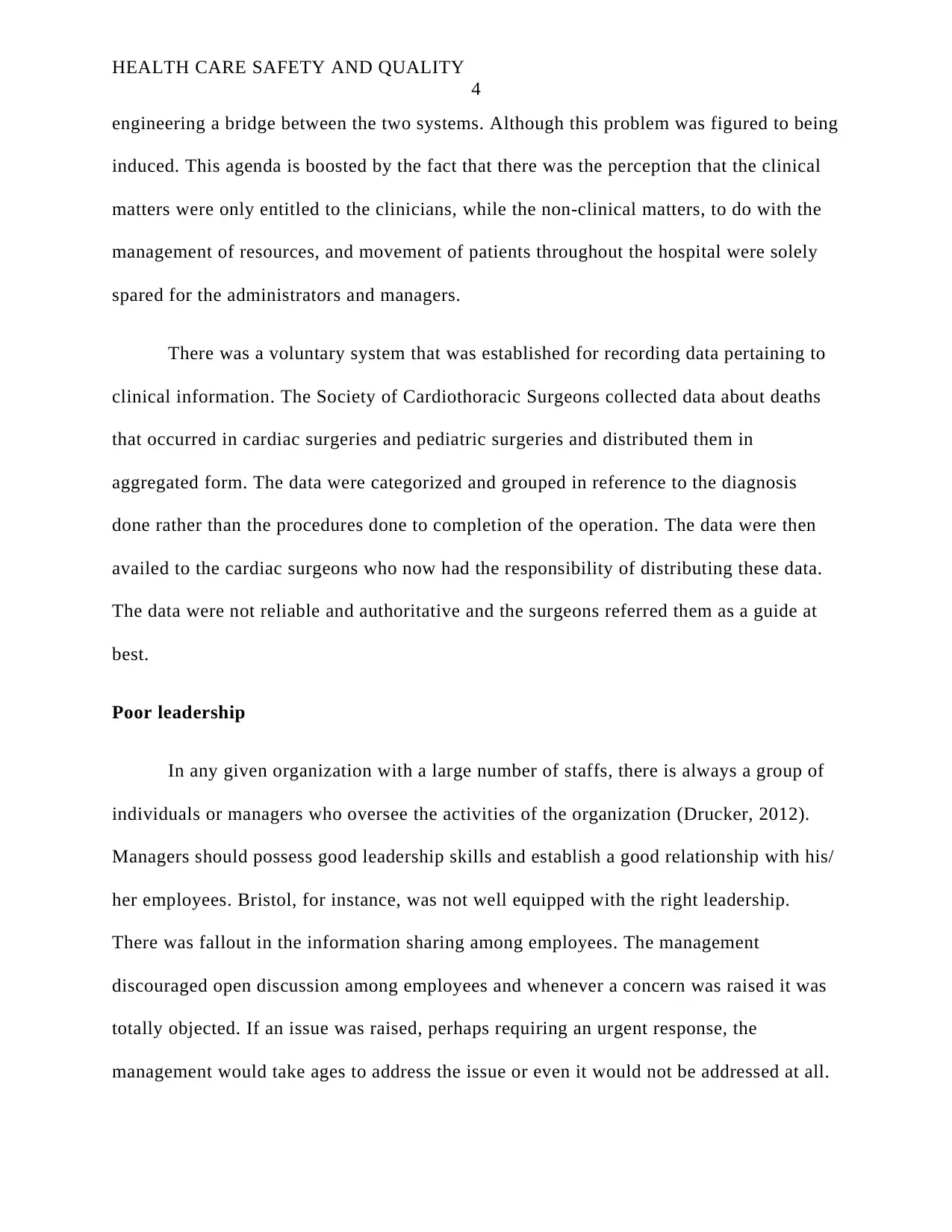
HEALTH CARE SAFETY AND QUALITY
4
engineering a bridge between the two systems. Although this problem was figured to being
induced. This agenda is boosted by the fact that there was the perception that the clinical
matters were only entitled to the clinicians, while the non-clinical matters, to do with the
management of resources, and movement of patients throughout the hospital were solely
spared for the administrators and managers.
There was a voluntary system that was established for recording data pertaining to
clinical information. The Society of Cardiothoracic Surgeons collected data about deaths
that occurred in cardiac surgeries and pediatric surgeries and distributed them in
aggregated form. The data were categorized and grouped in reference to the diagnosis
done rather than the procedures done to completion of the operation. The data were then
availed to the cardiac surgeons who now had the responsibility of distributing these data.
The data were not reliable and authoritative and the surgeons referred them as a guide at
best.
Poor leadership
In any given organization with a large number of staffs, there is always a group of
individuals or managers who oversee the activities of the organization (Drucker, 2012).
Managers should possess good leadership skills and establish a good relationship with his/
her employees. Bristol, for instance, was not well equipped with the right leadership.
There was fallout in the information sharing among employees. The management
discouraged open discussion among employees and whenever a concern was raised it was
totally objected. If an issue was raised, perhaps requiring an urgent response, the
management would take ages to address the issue or even it would not be addressed at all.
4
engineering a bridge between the two systems. Although this problem was figured to being
induced. This agenda is boosted by the fact that there was the perception that the clinical
matters were only entitled to the clinicians, while the non-clinical matters, to do with the
management of resources, and movement of patients throughout the hospital were solely
spared for the administrators and managers.
There was a voluntary system that was established for recording data pertaining to
clinical information. The Society of Cardiothoracic Surgeons collected data about deaths
that occurred in cardiac surgeries and pediatric surgeries and distributed them in
aggregated form. The data were categorized and grouped in reference to the diagnosis
done rather than the procedures done to completion of the operation. The data were then
availed to the cardiac surgeons who now had the responsibility of distributing these data.
The data were not reliable and authoritative and the surgeons referred them as a guide at
best.
Poor leadership
In any given organization with a large number of staffs, there is always a group of
individuals or managers who oversee the activities of the organization (Drucker, 2012).
Managers should possess good leadership skills and establish a good relationship with his/
her employees. Bristol, for instance, was not well equipped with the right leadership.
There was fallout in the information sharing among employees. The management
discouraged open discussion among employees and whenever a concern was raised it was
totally objected. If an issue was raised, perhaps requiring an urgent response, the
management would take ages to address the issue or even it would not be addressed at all.
Secure Best Marks with AI Grader
Need help grading? Try our AI Grader for instant feedback on your assignments.
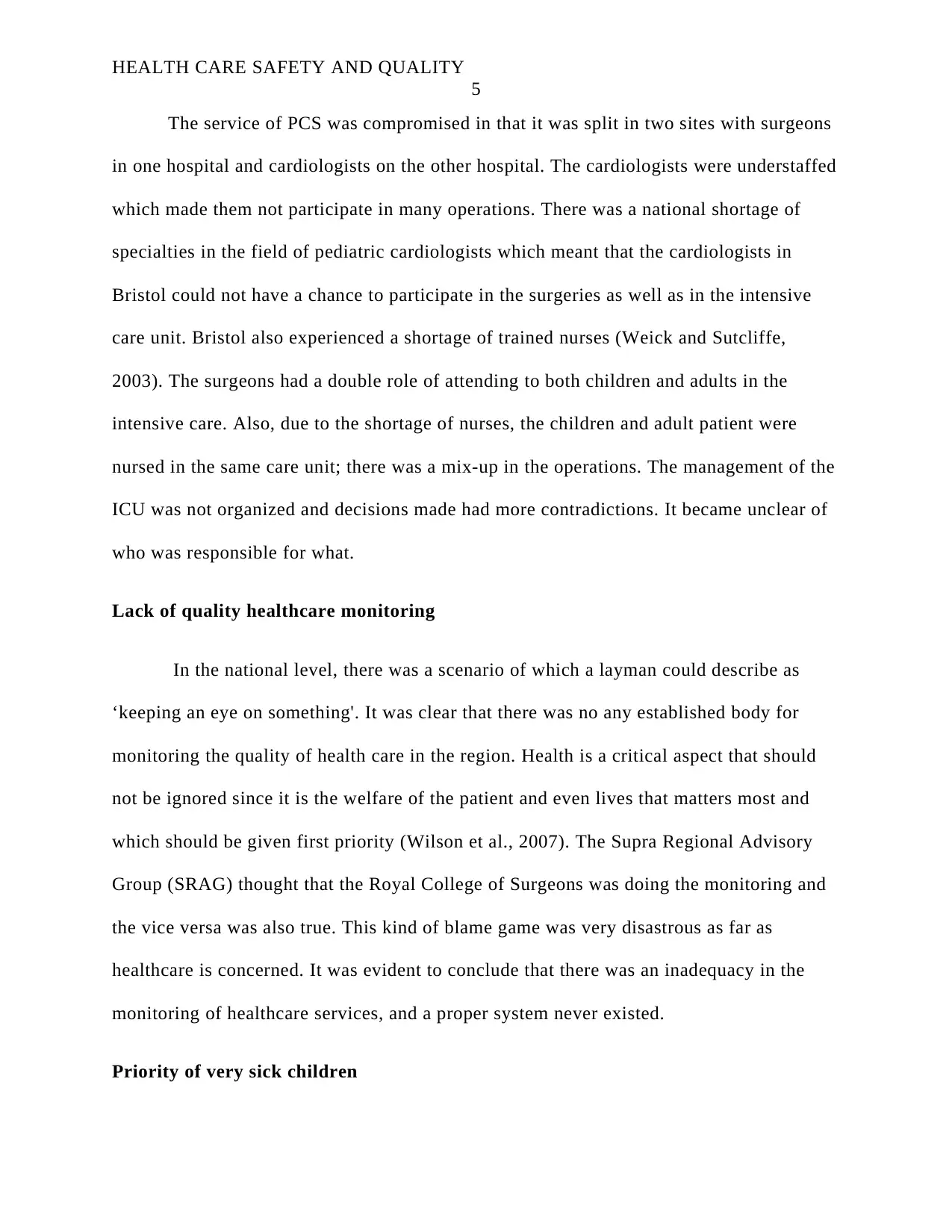
HEALTH CARE SAFETY AND QUALITY
5
The service of PCS was compromised in that it was split in two sites with surgeons
in one hospital and cardiologists on the other hospital. The cardiologists were understaffed
which made them not participate in many operations. There was a national shortage of
specialties in the field of pediatric cardiologists which meant that the cardiologists in
Bristol could not have a chance to participate in the surgeries as well as in the intensive
care unit. Bristol also experienced a shortage of trained nurses (Weick and Sutcliffe,
2003). The surgeons had a double role of attending to both children and adults in the
intensive care. Also, due to the shortage of nurses, the children and adult patient were
nursed in the same care unit; there was a mix-up in the operations. The management of the
ICU was not organized and decisions made had more contradictions. It became unclear of
who was responsible for what.
Lack of quality healthcare monitoring
In the national level, there was a scenario of which a layman could describe as
‘keeping an eye on something'. It was clear that there was no any established body for
monitoring the quality of health care in the region. Health is a critical aspect that should
not be ignored since it is the welfare of the patient and even lives that matters most and
which should be given first priority (Wilson et al., 2007). The Supra Regional Advisory
Group (SRAG) thought that the Royal College of Surgeons was doing the monitoring and
the vice versa was also true. This kind of blame game was very disastrous as far as
healthcare is concerned. It was evident to conclude that there was an inadequacy in the
monitoring of healthcare services, and a proper system never existed.
Priority of very sick children
5
The service of PCS was compromised in that it was split in two sites with surgeons
in one hospital and cardiologists on the other hospital. The cardiologists were understaffed
which made them not participate in many operations. There was a national shortage of
specialties in the field of pediatric cardiologists which meant that the cardiologists in
Bristol could not have a chance to participate in the surgeries as well as in the intensive
care unit. Bristol also experienced a shortage of trained nurses (Weick and Sutcliffe,
2003). The surgeons had a double role of attending to both children and adults in the
intensive care. Also, due to the shortage of nurses, the children and adult patient were
nursed in the same care unit; there was a mix-up in the operations. The management of the
ICU was not organized and decisions made had more contradictions. It became unclear of
who was responsible for what.
Lack of quality healthcare monitoring
In the national level, there was a scenario of which a layman could describe as
‘keeping an eye on something'. It was clear that there was no any established body for
monitoring the quality of health care in the region. Health is a critical aspect that should
not be ignored since it is the welfare of the patient and even lives that matters most and
which should be given first priority (Wilson et al., 2007). The Supra Regional Advisory
Group (SRAG) thought that the Royal College of Surgeons was doing the monitoring and
the vice versa was also true. This kind of blame game was very disastrous as far as
healthcare is concerned. It was evident to conclude that there was an inadequacy in the
monitoring of healthcare services, and a proper system never existed.
Priority of very sick children
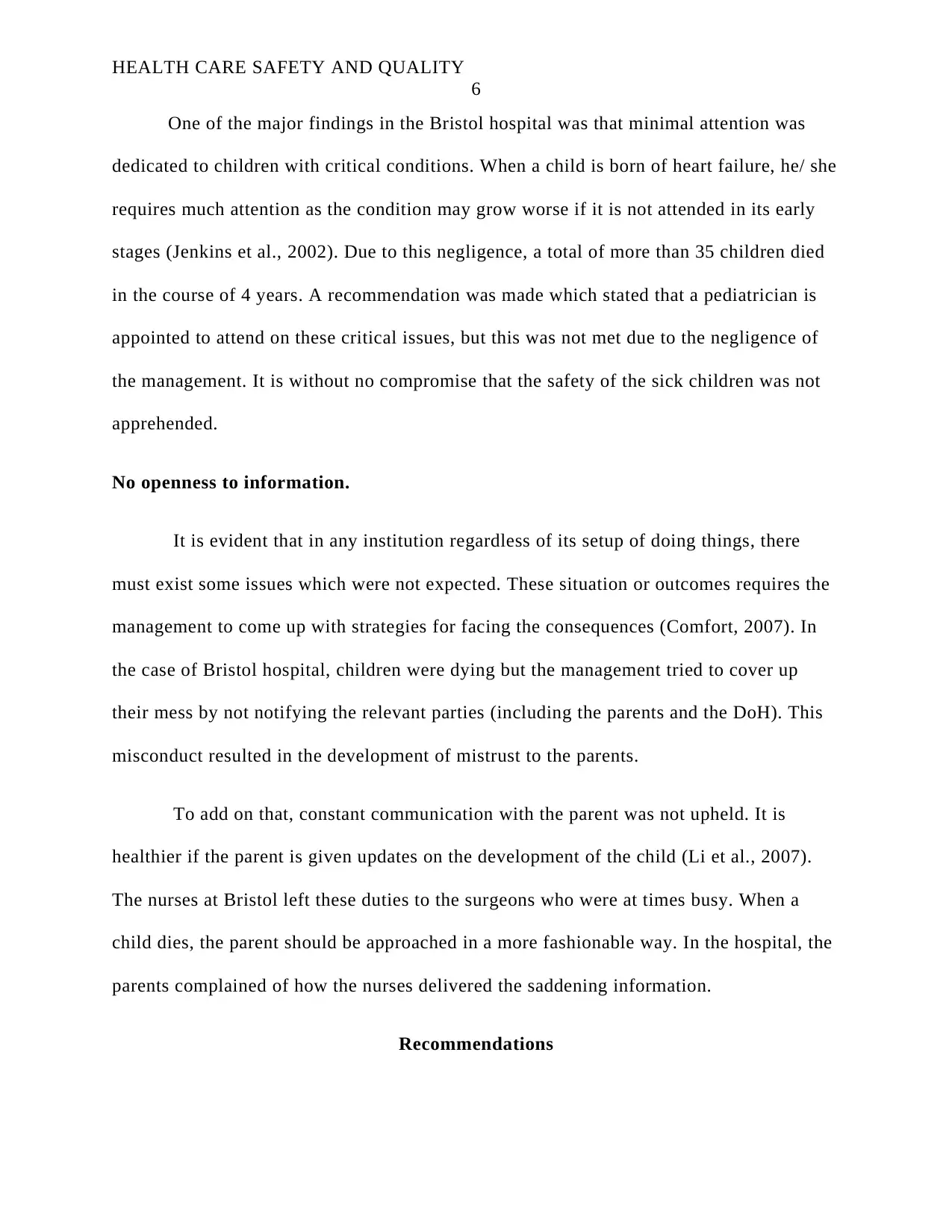
HEALTH CARE SAFETY AND QUALITY
6
One of the major findings in the Bristol hospital was that minimal attention was
dedicated to children with critical conditions. When a child is born of heart failure, he/ she
requires much attention as the condition may grow worse if it is not attended in its early
stages (Jenkins et al., 2002). Due to this negligence, a total of more than 35 children died
in the course of 4 years. A recommendation was made which stated that a pediatrician is
appointed to attend on these critical issues, but this was not met due to the negligence of
the management. It is without no compromise that the safety of the sick children was not
apprehended.
No openness to information.
It is evident that in any institution regardless of its setup of doing things, there
must exist some issues which were not expected. These situation or outcomes requires the
management to come up with strategies for facing the consequences (Comfort, 2007). In
the case of Bristol hospital, children were dying but the management tried to cover up
their mess by not notifying the relevant parties (including the parents and the DoH). This
misconduct resulted in the development of mistrust to the parents.
To add on that, constant communication with the parent was not upheld. It is
healthier if the parent is given updates on the development of the child (Li et al., 2007).
The nurses at Bristol left these duties to the surgeons who were at times busy. When a
child dies, the parent should be approached in a more fashionable way. In the hospital, the
parents complained of how the nurses delivered the saddening information.
Recommendations
6
One of the major findings in the Bristol hospital was that minimal attention was
dedicated to children with critical conditions. When a child is born of heart failure, he/ she
requires much attention as the condition may grow worse if it is not attended in its early
stages (Jenkins et al., 2002). Due to this negligence, a total of more than 35 children died
in the course of 4 years. A recommendation was made which stated that a pediatrician is
appointed to attend on these critical issues, but this was not met due to the negligence of
the management. It is without no compromise that the safety of the sick children was not
apprehended.
No openness to information.
It is evident that in any institution regardless of its setup of doing things, there
must exist some issues which were not expected. These situation or outcomes requires the
management to come up with strategies for facing the consequences (Comfort, 2007). In
the case of Bristol hospital, children were dying but the management tried to cover up
their mess by not notifying the relevant parties (including the parents and the DoH). This
misconduct resulted in the development of mistrust to the parents.
To add on that, constant communication with the parent was not upheld. It is
healthier if the parent is given updates on the development of the child (Li et al., 2007).
The nurses at Bristol left these duties to the surgeons who were at times busy. When a
child dies, the parent should be approached in a more fashionable way. In the hospital, the
parents complained of how the nurses delivered the saddening information.
Recommendations
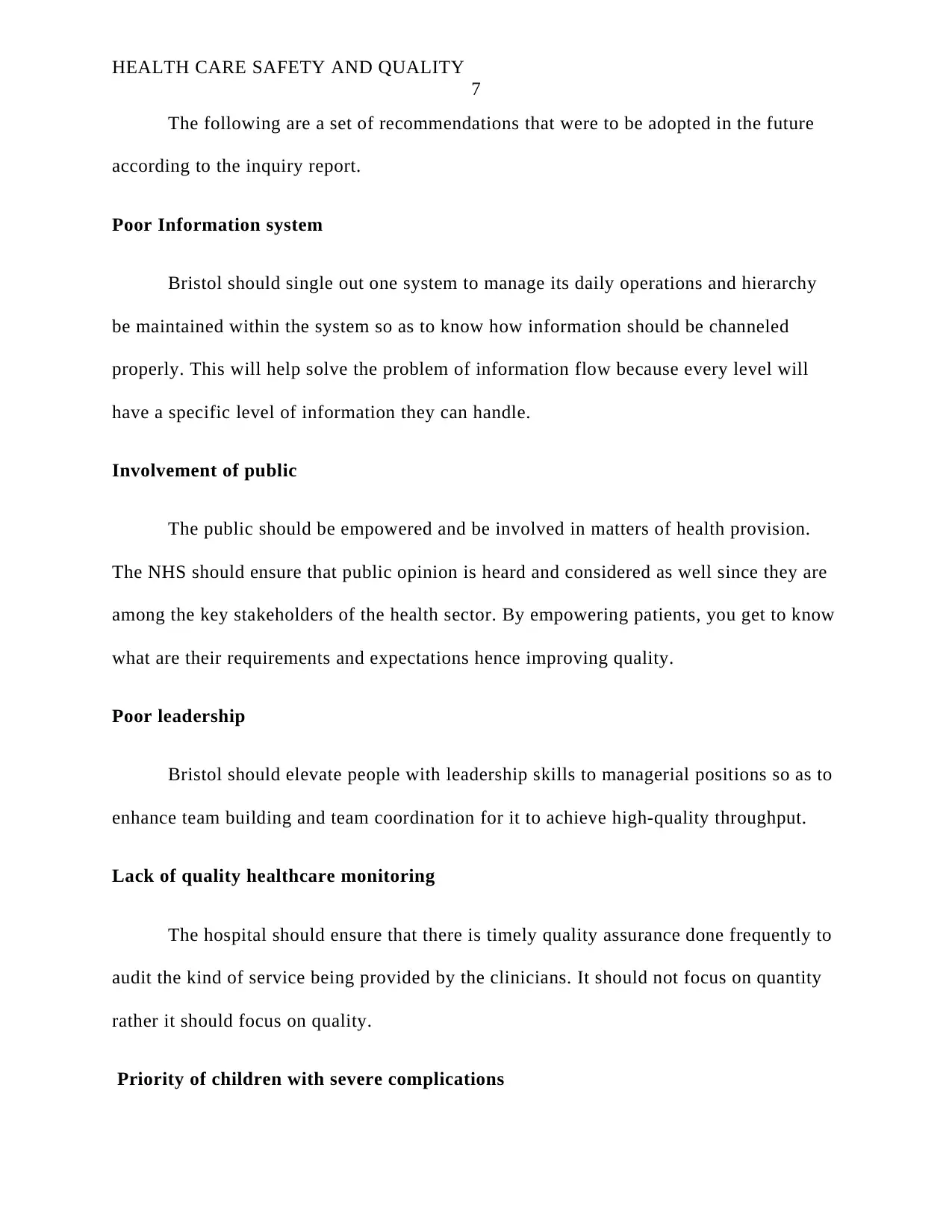
HEALTH CARE SAFETY AND QUALITY
7
The following are a set of recommendations that were to be adopted in the future
according to the inquiry report.
Poor Information system
Bristol should single out one system to manage its daily operations and hierarchy
be maintained within the system so as to know how information should be channeled
properly. This will help solve the problem of information flow because every level will
have a specific level of information they can handle.
Involvement of public
The public should be empowered and be involved in matters of health provision.
The NHS should ensure that public opinion is heard and considered as well since they are
among the key stakeholders of the health sector. By empowering patients, you get to know
what are their requirements and expectations hence improving quality.
Poor leadership
Bristol should elevate people with leadership skills to managerial positions so as to
enhance team building and team coordination for it to achieve high-quality throughput.
Lack of quality healthcare monitoring
The hospital should ensure that there is timely quality assurance done frequently to
audit the kind of service being provided by the clinicians. It should not focus on quantity
rather it should focus on quality.
Priority of children with severe complications
7
The following are a set of recommendations that were to be adopted in the future
according to the inquiry report.
Poor Information system
Bristol should single out one system to manage its daily operations and hierarchy
be maintained within the system so as to know how information should be channeled
properly. This will help solve the problem of information flow because every level will
have a specific level of information they can handle.
Involvement of public
The public should be empowered and be involved in matters of health provision.
The NHS should ensure that public opinion is heard and considered as well since they are
among the key stakeholders of the health sector. By empowering patients, you get to know
what are their requirements and expectations hence improving quality.
Poor leadership
Bristol should elevate people with leadership skills to managerial positions so as to
enhance team building and team coordination for it to achieve high-quality throughput.
Lack of quality healthcare monitoring
The hospital should ensure that there is timely quality assurance done frequently to
audit the kind of service being provided by the clinicians. It should not focus on quantity
rather it should focus on quality.
Priority of children with severe complications
Paraphrase This Document
Need a fresh take? Get an instant paraphrase of this document with our AI Paraphraser
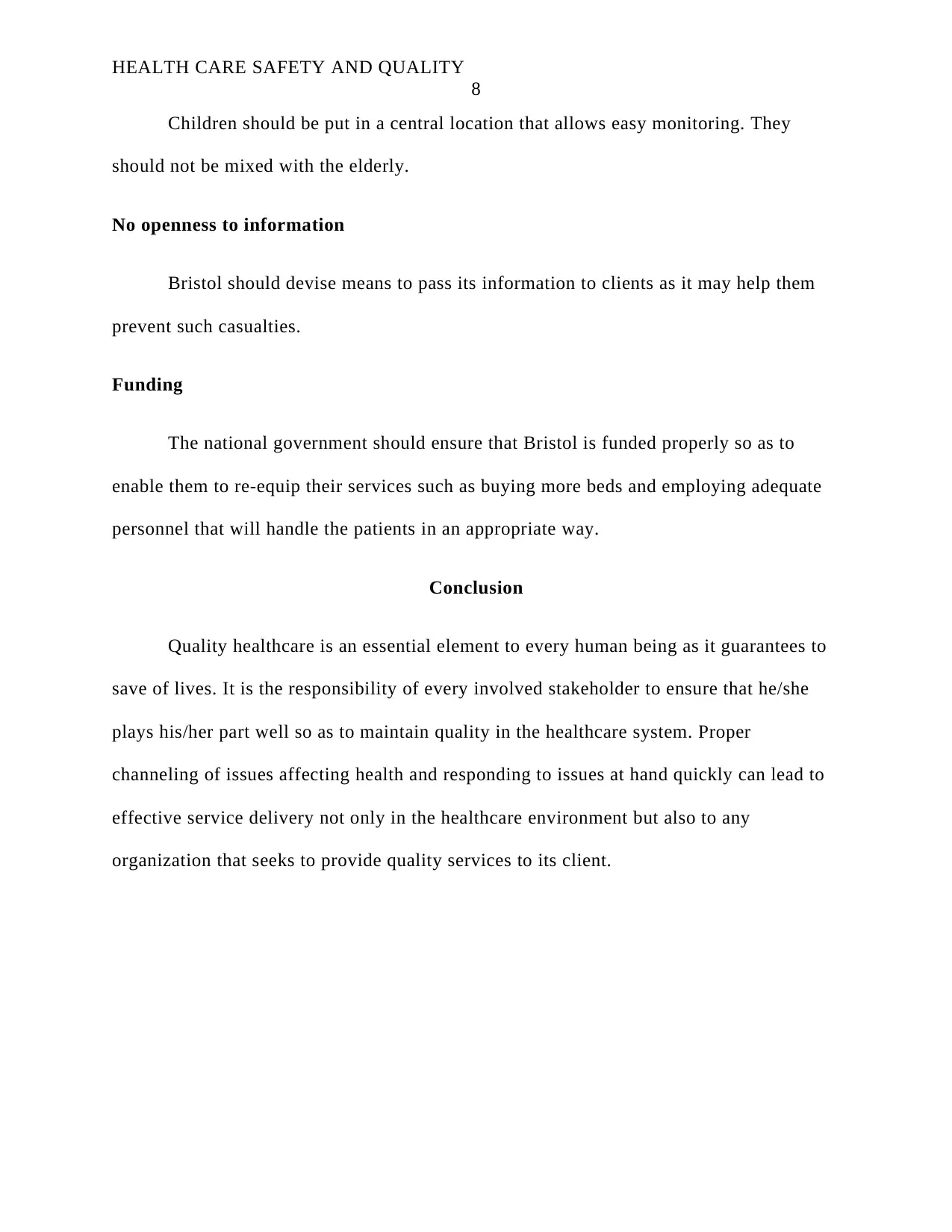
HEALTH CARE SAFETY AND QUALITY
8
Children should be put in a central location that allows easy monitoring. They
should not be mixed with the elderly.
No openness to information
Bristol should devise means to pass its information to clients as it may help them
prevent such casualties.
Funding
The national government should ensure that Bristol is funded properly so as to
enable them to re-equip their services such as buying more beds and employing adequate
personnel that will handle the patients in an appropriate way.
Conclusion
Quality healthcare is an essential element to every human being as it guarantees to
save of lives. It is the responsibility of every involved stakeholder to ensure that he/she
plays his/her part well so as to maintain quality in the healthcare system. Proper
channeling of issues affecting health and responding to issues at hand quickly can lead to
effective service delivery not only in the healthcare environment but also to any
organization that seeks to provide quality services to its client.
8
Children should be put in a central location that allows easy monitoring. They
should not be mixed with the elderly.
No openness to information
Bristol should devise means to pass its information to clients as it may help them
prevent such casualties.
Funding
The national government should ensure that Bristol is funded properly so as to
enable them to re-equip their services such as buying more beds and employing adequate
personnel that will handle the patients in an appropriate way.
Conclusion
Quality healthcare is an essential element to every human being as it guarantees to
save of lives. It is the responsibility of every involved stakeholder to ensure that he/she
plays his/her part well so as to maintain quality in the healthcare system. Proper
channeling of issues affecting health and responding to issues at hand quickly can lead to
effective service delivery not only in the healthcare environment but also to any
organization that seeks to provide quality services to its client.

HEALTH CARE SAFETY AND QUALITY
9
References
Alaszewski, A. (2002). The impact of the Bristol Royal Infirmary disaster and inquiry
on public services in the UK. Journal of interprofessional care, 16(4), 371-378.
Aylin, P., Alves, B., Best, N., Cook, A., Elliott, P., Evans, S. J., ... & Spieǵelhalter, D.
(2001). Comparison of UK paediatric cardiac surgical performance by analysis of
routinely collected data 1984–96: was Bristol an outlier?. The Lancet, 358(9277),
181-187.
Billett, J., Cowie, M. R., Gatzoulis, M. A., Muhll, I. V., & Majeed, A. (2008).
Comorbidity, healthcare utilisation and process of care measures in patients with
congenital heart disease in the UK: cross-sectional, population-based study with
case–control analysis. Heart, 94(9), 1194-1199.
Comfort, L. K. (2007). Crisis management in hindsight: Cognition, communication,
coordination, and control. Public Administration Review, 67, 189-197.
Drucker, P. (2012). The practice of management. Routledge.
Feltes, T. F., Cabalka, A. K., Meissner, H. C., Piazza, F. M., Carlin, D. A., Top Jr, F.
H., ... & Cardiac Synagis Study Group. (2003). Palivizumab prophylaxis reduces
hospitalization due to respiratory syncytial virus in young children with
hemodynamically significant congenital heart disease. The Journal of pediatrics,
143(4), 532-540..
9
References
Alaszewski, A. (2002). The impact of the Bristol Royal Infirmary disaster and inquiry
on public services in the UK. Journal of interprofessional care, 16(4), 371-378.
Aylin, P., Alves, B., Best, N., Cook, A., Elliott, P., Evans, S. J., ... & Spieǵelhalter, D.
(2001). Comparison of UK paediatric cardiac surgical performance by analysis of
routinely collected data 1984–96: was Bristol an outlier?. The Lancet, 358(9277),
181-187.
Billett, J., Cowie, M. R., Gatzoulis, M. A., Muhll, I. V., & Majeed, A. (2008).
Comorbidity, healthcare utilisation and process of care measures in patients with
congenital heart disease in the UK: cross-sectional, population-based study with
case–control analysis. Heart, 94(9), 1194-1199.
Comfort, L. K. (2007). Crisis management in hindsight: Cognition, communication,
coordination, and control. Public Administration Review, 67, 189-197.
Drucker, P. (2012). The practice of management. Routledge.
Feltes, T. F., Cabalka, A. K., Meissner, H. C., Piazza, F. M., Carlin, D. A., Top Jr, F.
H., ... & Cardiac Synagis Study Group. (2003). Palivizumab prophylaxis reduces
hospitalization due to respiratory syncytial virus in young children with
hemodynamically significant congenital heart disease. The Journal of pediatrics,
143(4), 532-540..
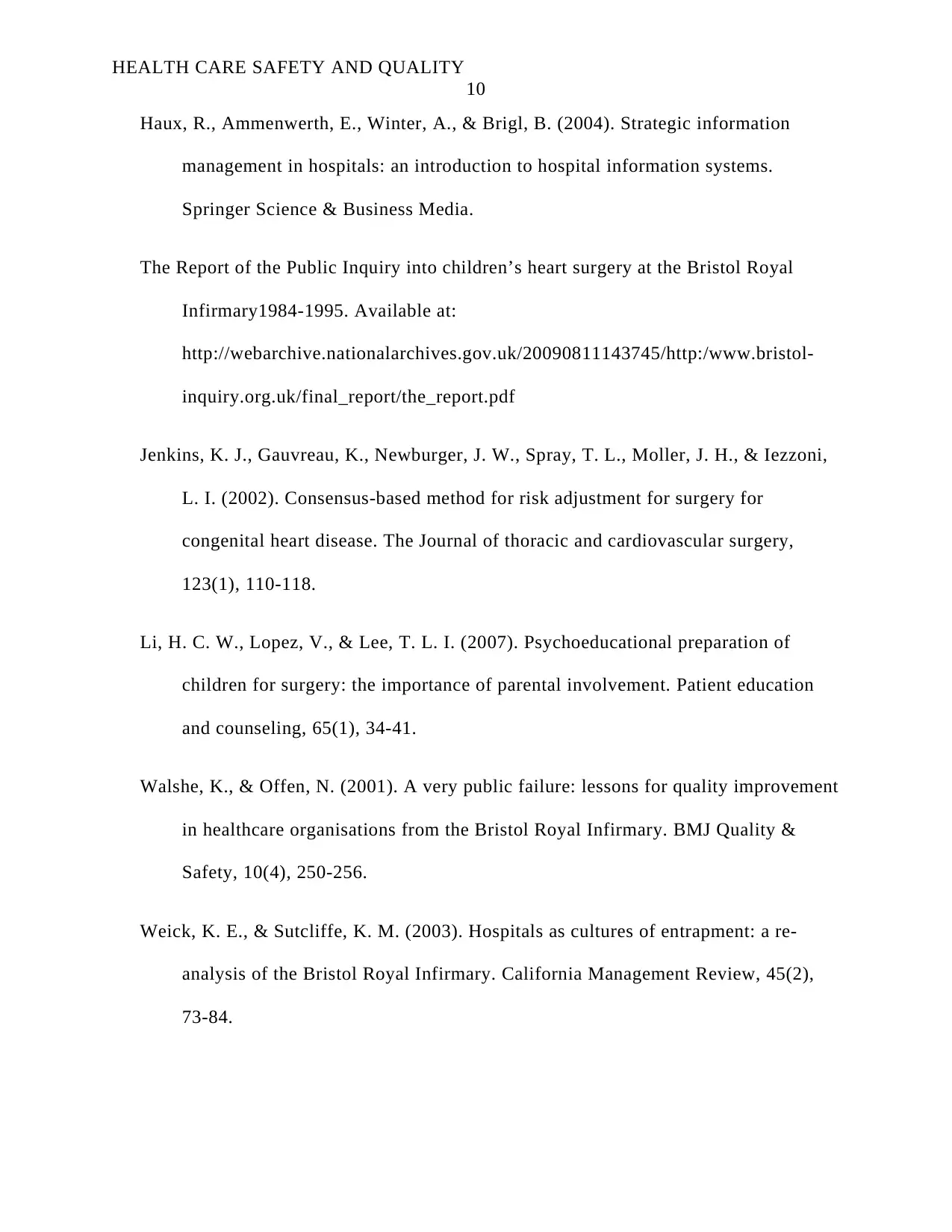
HEALTH CARE SAFETY AND QUALITY
10
Haux, R., Ammenwerth, E., Winter, A., & Brigl, B. (2004). Strategic information
management in hospitals: an introduction to hospital information systems.
Springer Science & Business Media.
The Report of the Public Inquiry into children’s heart surgery at the Bristol Royal
Infirmary1984-1995. Available at:
http://webarchive.nationalarchives.gov.uk/20090811143745/http:/www.bristol-
inquiry.org.uk/final_report/the_report.pdf
Jenkins, K. J., Gauvreau, K., Newburger, J. W., Spray, T. L., Moller, J. H., & Iezzoni,
L. I. (2002). Consensus-based method for risk adjustment for surgery for
congenital heart disease. The Journal of thoracic and cardiovascular surgery,
123(1), 110-118.
Li, H. C. W., Lopez, V., & Lee, T. L. I. (2007). Psychoeducational preparation of
children for surgery: the importance of parental involvement. Patient education
and counseling, 65(1), 34-41.
Walshe, K., & Offen, N. (2001). A very public failure: lessons for quality improvement
in healthcare organisations from the Bristol Royal Infirmary. BMJ Quality &
Safety, 10(4), 250-256.
Weick, K. E., & Sutcliffe, K. M. (2003). Hospitals as cultures of entrapment: a re-
analysis of the Bristol Royal Infirmary. California Management Review, 45(2),
73-84.
10
Haux, R., Ammenwerth, E., Winter, A., & Brigl, B. (2004). Strategic information
management in hospitals: an introduction to hospital information systems.
Springer Science & Business Media.
The Report of the Public Inquiry into children’s heart surgery at the Bristol Royal
Infirmary1984-1995. Available at:
http://webarchive.nationalarchives.gov.uk/20090811143745/http:/www.bristol-
inquiry.org.uk/final_report/the_report.pdf
Jenkins, K. J., Gauvreau, K., Newburger, J. W., Spray, T. L., Moller, J. H., & Iezzoni,
L. I. (2002). Consensus-based method for risk adjustment for surgery for
congenital heart disease. The Journal of thoracic and cardiovascular surgery,
123(1), 110-118.
Li, H. C. W., Lopez, V., & Lee, T. L. I. (2007). Psychoeducational preparation of
children for surgery: the importance of parental involvement. Patient education
and counseling, 65(1), 34-41.
Walshe, K., & Offen, N. (2001). A very public failure: lessons for quality improvement
in healthcare organisations from the Bristol Royal Infirmary. BMJ Quality &
Safety, 10(4), 250-256.
Weick, K. E., & Sutcliffe, K. M. (2003). Hospitals as cultures of entrapment: a re-
analysis of the Bristol Royal Infirmary. California Management Review, 45(2),
73-84.
Secure Best Marks with AI Grader
Need help grading? Try our AI Grader for instant feedback on your assignments.
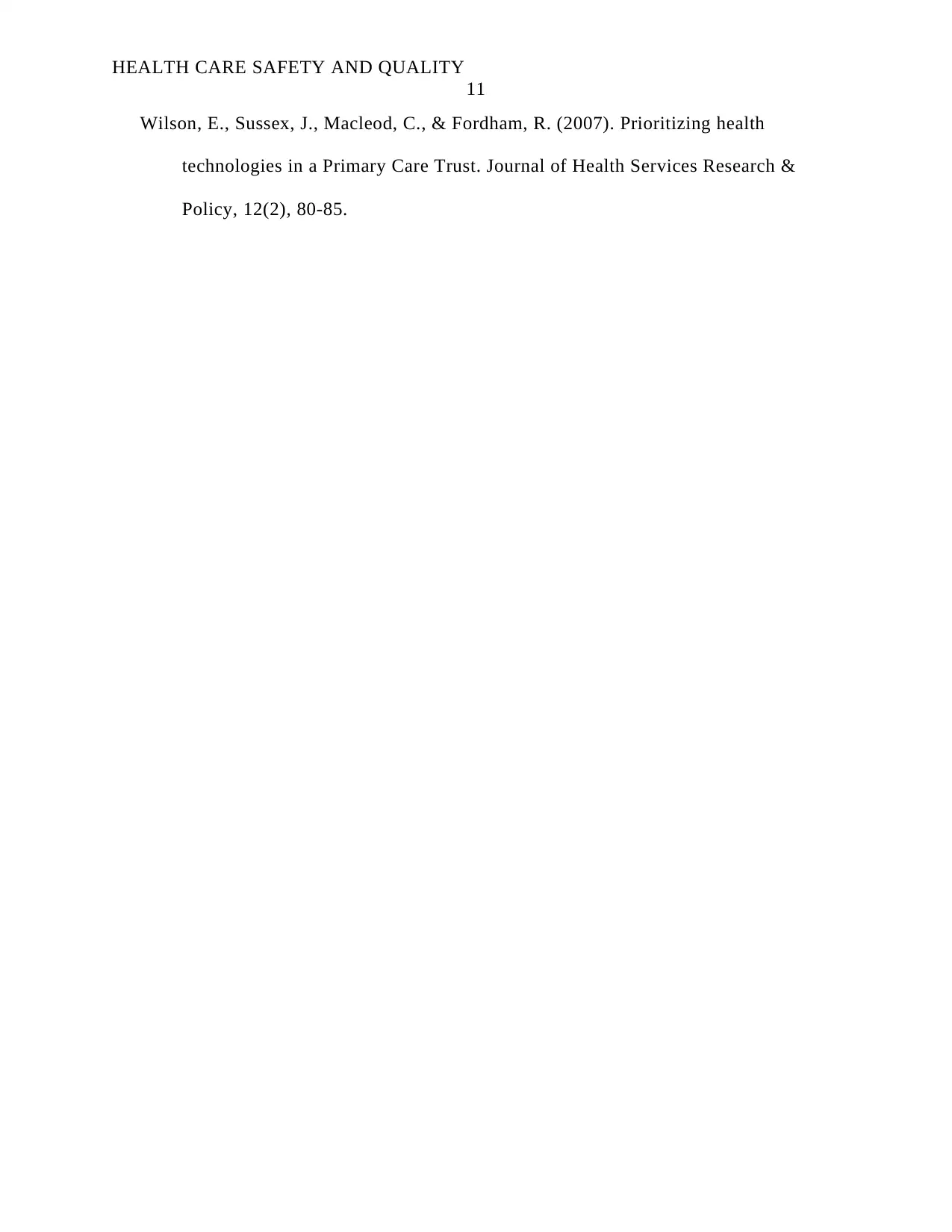
HEALTH CARE SAFETY AND QUALITY
11
Wilson, E., Sussex, J., Macleod, C., & Fordham, R. (2007). Prioritizing health
technologies in a Primary Care Trust. Journal of Health Services Research &
Policy, 12(2), 80-85.
11
Wilson, E., Sussex, J., Macleod, C., & Fordham, R. (2007). Prioritizing health
technologies in a Primary Care Trust. Journal of Health Services Research &
Policy, 12(2), 80-85.
1 out of 11
Related Documents
Your All-in-One AI-Powered Toolkit for Academic Success.
+13062052269
info@desklib.com
Available 24*7 on WhatsApp / Email
![[object Object]](/_next/static/media/star-bottom.7253800d.svg)
Unlock your academic potential
© 2024 | Zucol Services PVT LTD | All rights reserved.





